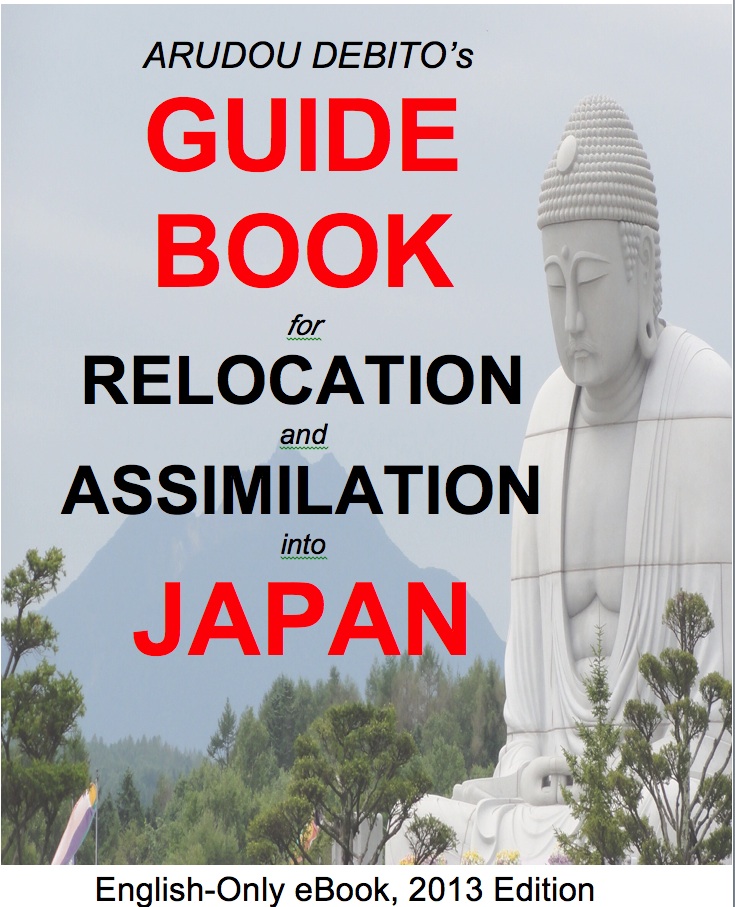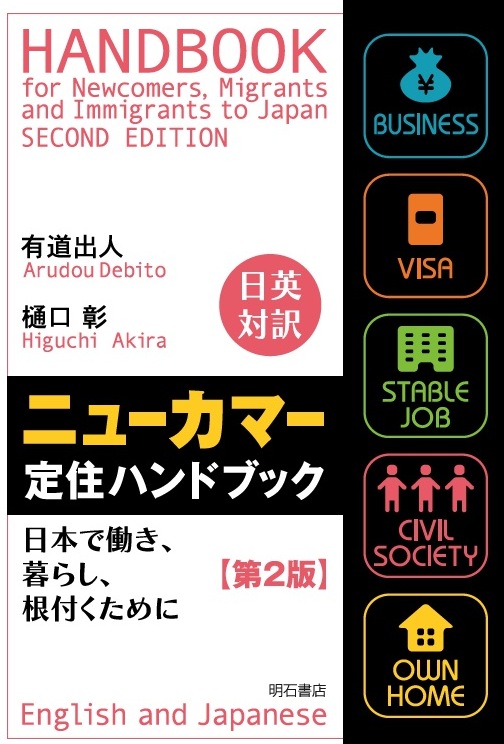mytest
Books, eBooks, and more from Dr. ARUDOU, Debito (click on icon):





![]()


UPDATES ON TWITTER: arudoudebito
DEBITO.ORG PODCASTS on iTunes, subscribe free
“LIKE” US on Facebook at http://www.facebook.com/debitoorg
https://www.facebook.com/embeddedrcsmJapan
http://www.facebook.com/handbookimmigrants
https://www.facebook.com/JapaneseOnlyTheBook
https://www.facebook.com/BookInAppropriate
If you like what you read and discuss on Debito.org, please consider helping us stop hackers and defray maintenance costs with a little donation via my webhoster:

All donations go towards website costs only. Thanks for your support!
Debito’s latest publication is in in the Washington University Global Studies Law Review (Vol.14, No.4):
Japan’s Under-Researched Visible Minorities: Applying Critical Race Theory to Racialization Dynamics in a Non-White Society
Dr. Debito Arudou
Washington University Global Studies Law Review
Abstract
Critical Race Theory (CRT), an analytical framework grounded in American legal academia, uncovers power relationships between a racialized enfranchised majority and a disenfranchised minority. Although applied primarily to countries and societies with Caucasian majorities to analyze White Privilege this Article applies CRT to Japan, a non-White majority society. After discussing how scholarship on Japan has hitherto ignored a fundamental factor within racialization studies—the effects of skin color on the concept of “Japaneseness”—this Article examines an example of published research on the Post-WWII “konketsuji problem.” This research finds blind spots in the analysis, and re-examines it through CRT to uncover more nuanced power dynamics. This exercise attempts to illustrate the universality of nation-state racialization processes, and advocates the expansion of Whiteness Studies beyond Caucasian-majority societies into worldwide Colorism dynamics in general.
Recommended Citation
Dr. Debito Arudou, Japan’s Under-Researched Visible Minorities: Applying Critical Race Theory to Racialization Dynamics in a Non-White Society, 14 Wash. U. Global Stud. L. Rev. 695 (2015),
http://openscholarship.wustl.edu/law_globalstudies/vol14/iss4/13
==========================
Do you like what you read on Debito.org? Want to help keep the archive active and support Debito.org’s activities? We are celebrating Debito.org’s 20th Anniversary in 2016, so please consider donating a little something. More details here.
5 comments on ““Japan’s Under-Researched Visible Minorities: Applying Critical Race Theory to Racialization Dynamics in a Non-White Society”. Journal article in Washington University Global Studies Law Review 14(4) 2015”
J supremacists/Nihonjinron subconsciously regard themselves as equivalent to or on a par with whites, and have always aspired to join the Western Club (on their own terms), hence their striving for western acceptance (or acquiescence) for their emulation of “western culture”, even if this involves colonial or imperial exploitation (of China and other Asians). From the Meiji Era thru Mishima, to G7 and Abe, that is a major obsession of the ruling elite vis a vis their relationship with NJs and how they are perceived by the (western) world.
Thus, concepts of White Privilege can be easily applied to Japanese.
Coincidentally I was reading about “Burapan” yesterday, i.e. Japanese who want to be black or are into black culture (as they see it) to the point of tanning their skin.
This was seen as 1. a rebellion against cultural norms by those who felt excluded 2. Simultaneously looked down upon as “burapan” was originally a euphemism for “prostitute” 3. Only possible during economically comfortable times (80s, 90s).
So with Abe’s Zeitgeist (i.e. “Right, you have had your fun but now its back to being a salaryman for the glory of Nippon”) I wonder if we will see more conformity and less acquisition of racial minority identities by rebels from the majority race so that they can find an alternative club to join.
I have mixed feelings about these “racial minority groupies”. Its positive discrimination, but at the same time, its fetishism. And often it is the choosing of one race, e.g. black fashion, at the expense of others (no interest in Asians or whites). Which strikes me as just another example of certain Japanese consumers picking and choosing the NJ of their choice like an accessory to their identity.
This dovetails with the discussion we had recently about “moments”, the Dreamy Day, and fake DJs and Surfers, i.e. false consciousness, Commodity Fetish and Identity Creation.
Relationships mediated by Images. And in the case of Japan, Race is an Image.
Thanks for posting this, glad it is open access.
@ @ Baudrillard #1
Yes, I totally agree.
Japanese imperial era remnant world-view binary ‘us V’s them’ mentality demands that all nationalities be reduced to stylized stereotypes in order to deny the existence of plurality and individualism, thereby allowing nihonjinron-giron to present NJ as monolithic entities within the context of overall ‘gaijin-ness’. This in itself denigrates other ethnicities, cultures, and nationalities, but (importantly) allows nihonjinron-giron advocates to perpetuate oppressive myths about monolithic ‘we Japanese’.
As a by product, it has made the commercialization of facile understanding of ‘the other’ very simple.
I agree with Baudrillards analysis of the burapan. Curiously, where did all those girls disappear too? You rarely see one anymore. I was always creeped out by them. Not really understanding black culture or struggle, but trying to appropriate it as their own
I also strongly agree with your last paragraph, and have had this confirmed by a Japanese student before. He told me Japanese are all different; some like whites, Asians, blacks etc.
However, I have never really bought into the white emulation theory. Ive always been treated as a boy, like an adolescent, who is never allowed to reach adulthood. Your expected to act as such, in return receive the blessings and fake care from a benevolent senior. Perhaps this relates to a different topic under the same subject, that is, whites who live in Japan vs whites who are admired by Japan, from afar.
It provides for a strange paradox. Japanese seem to admire whites in their natural setting, but want nothing to do with them in their own.
@ Tim,where did all those girls disappear too? You rarely see one anymore.” They could only flourish under better economic conditions and the pre-Abe, more tolerant society. Now they have to get office jobs to survive. Or maybe they moved to America, if they were genuinely interested. Maybe a few diehards down in Yokohama and Yokosuka.
“Not really understanding black culture or struggle, but trying to appropriate it as their own”
Oh, for sure. Japanese Discrimination is mainly Postmodern Race Fetishism and Identity Creation/issues of Image. The majority see the NJ look as a fashion to be appropriated. Oddly, these Shibuya girls are the ones least likely to speak English or even have genuine interest in Johnny Foreigner-they just want the clothes and contact lenses.
“Japanese seem to admire whites in their natural setting”
To quote one of Debito’s favorite rock stars, “It is always great to VISIT Japan, as they take good care of you. So long as you LEAVE when you are supposed to”.
The British National (Nazi) Party were invited to Yasukuni a few years back, something I found very odd and fundamentally against British Nationalist interests, but I suppose their common ground, between Nationalist parties of all countries is this basic “Natural setting” thinking, i.e. “Dont mind (Whites) in their own country”. “Separate but Equal” etc etc.
So as this idea so permeates fundamental thinking of quite a few Japanese, i.e stereotyping VIP Gaijin as Visitor, NJ Resident as incomprehensible Loser outside the hierarchy so possibly at the bottom, one can conclude that Japan is essentially a Nationalist country.
“some like whites, Asians, blacks etc.”
Its really horrible and offensive, like my former student who said “I hate English, but this school is the nearest to my home but it doesnt offer French lessons. However, as you are half French and look a bit “French” (???) I ll take your English lesson.”
She had majored in Art History in Keio, and was into “French lifestyle” the food, the art- itself an awfully shallow, pretentious but popular “lifestyle choice” for upper middle class Asians (French wine is also a huge cultural import in China and Hong Kong has the biggest expat French population other than London) with time on their hands.
Sadly, I have yet to meet a single one of these poseurs who knows the philosophy of Baudrillard, Vaneigem, or even Voltaire. (OK, maybe Voltaire). Because ideas are not purchasable in a happy consumerist setting. And it flies in the face, indeed challenges, the Dreamy Day.
So all you can do is make the most of it, to your advantage, but who is using who? Its positive discrimination, but its still discrimination. You ll constantly be wondering how genuine a relationship it is you are experiencing. I knew an African American married to a Japanese woman who had a degree in African American studies- so at least this is a deep understanding and appreciation of the culture she is arguably possibly appropriating.
Otherwise, you are just a part of an Image, in Debord’s Relationships mediated by Images.
E.g. Burapan meets Rapper. But when Rapper starts talking in a posh British accent, the Fetishist is disappointed and feels “cheated” “You are not a real African American, like in the Hollywood movies!”
As satirized by Little Britain….
https://www.youtube.com/watch?v=lHaHZIoxDEA
The Fake, the Simulation, has become more prized than the Original.
The White Stereotype is in fact several stereotypes, so at least there is a bit more flexibility, e.g. English Teacher to Expat Banker, to “re invent yourself”
I would say blacks have it worse-with a much narrower “Stereotypical job description” as a large subsection of Japanese have “completely bought into the stereotype that blacks have rhythm, are good dancers and rappers etc” (Powers, Working in Japan, 1990). I am glad Obama has broken their illusion to some extent, but fear he may just be, in their minds, the exception that proves the rule.